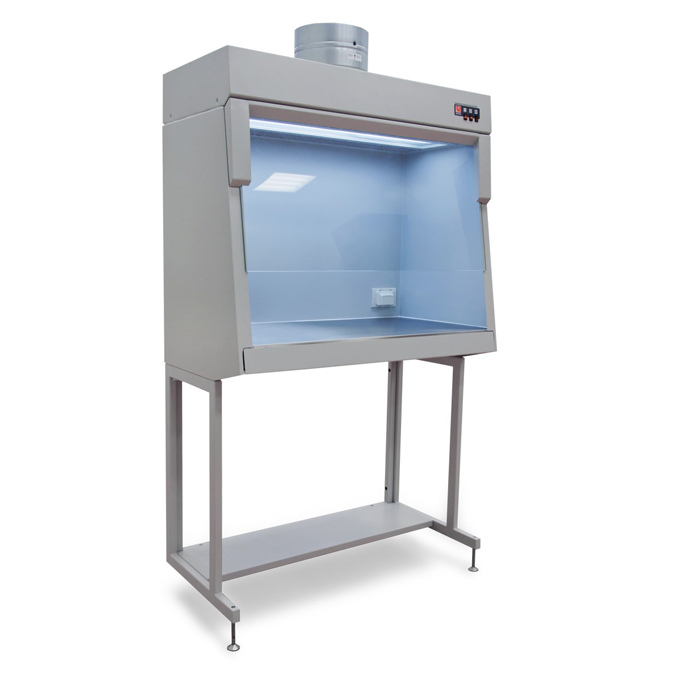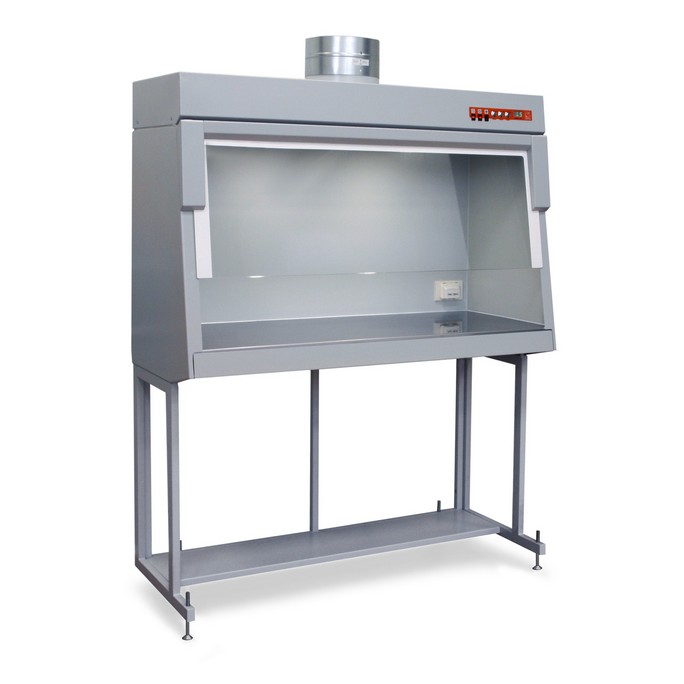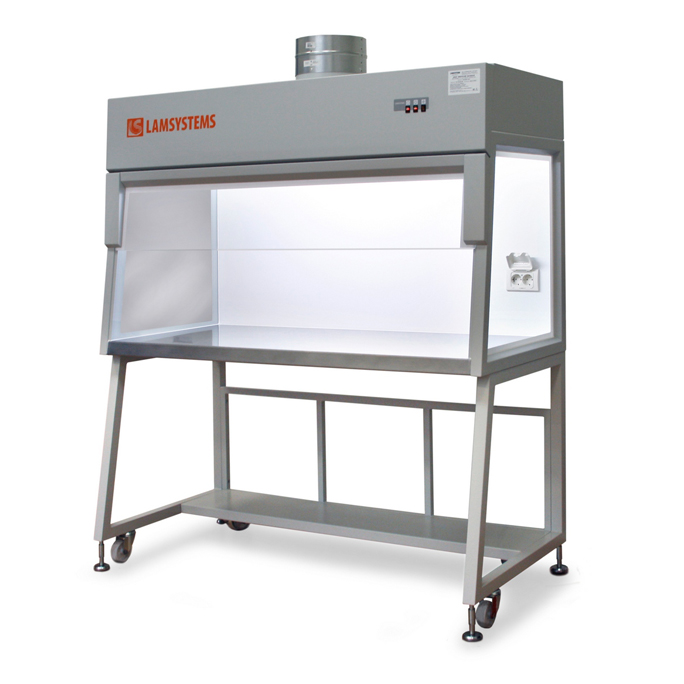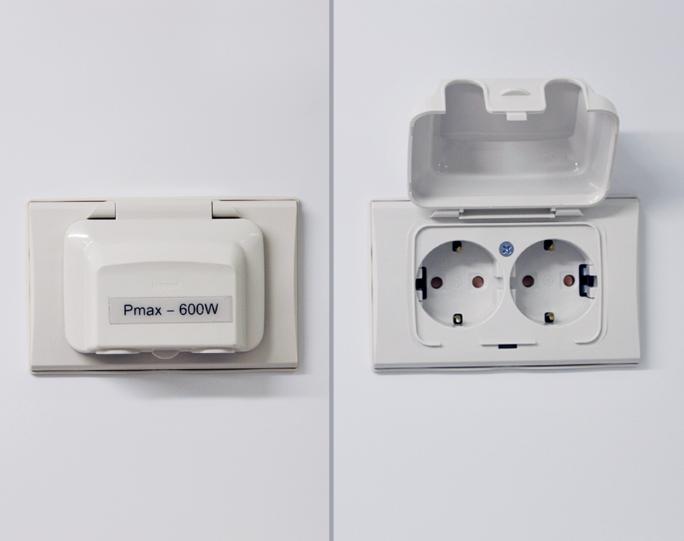In the 1970s and 1980s, fume hoods underwent significant improvements in terms of their design and performance. Modern LFHs are constructed from more durable and resistant materials, such as epoxy powder-coated steel and flame-retardant plastic laminates. They can be classified into two main categories:
- Ducted fume hoods. These are connected to an external exhaust system that removes the contaminated air from the laboratory and discharges it into the atmosphere.
- Recirculating fume hoods. These use internal filters to capture and neutralize pollutants and recirculate clean air back into the room.
Both types have their own application in different scientific fields. A laboratory fume hood is essential for conducting experiments in a modern setting. Below, we will take you on a journey through our assortment of LFHs.
FUME HOOD SHV-1,0-“Laminar-S.”

These devices protect laboratory workers from exposure to low-toxic fumes, vapors, and dust. They are not for use with hazardous pathogenic agents or microorganisms. LFHs are widely used in various fields of science, including:
- Chemistry. For handling volatile solvents, such as acetone, ethanol, or chloroform, that may pose fire or inhalation hazards.
- Biology. For synthesizing organic compounds, culturing bacteria, viruses, or cells, or manipulating DNA or RNA.
This model of LFH enables researchers to perform experiments that would otherwise be impossible or dangerous to conduct. The dimensions of Fume Hood SHV-1,0-“Laminar-S.” are 1,020х621х1,920 mm.
FUME HOOD SHV-1,3-“Laminar-S.”

They also protect the environment and the public from the harmful effects of laboratory waste and emissions. FUME HOOD SHV-1,3-“Laminar-S.” is therefore indispensable for any modern laboratory that values safety, quality, and innovation. Engineering, pharmaceuticals, and medicine are the main fields of application. The dimensions of this model are:
- Width — 1,315 mm;
- Depth — 621 mm;
- Height — 1,920 mm.
They also incorporate more sophisticated features, such as foot pedals, fuse blocks, and gas taps. These enhancements increase the safety and energy efficiency of this model and reduce its operating costs.
FUME HOOD SHV-1,5-“Laminar-S.”

SHV-1,5-“Laminar-S.” incorporates innovations and improvements made to the original concept of LFHs. It features a metal frame, protected lamps, and a front window made from stained glass. Some examples of fume hood applications in engineering are:
- Testing or developing combustion engines.
- Fabricating or welding metals.
- Applying coatings that contain volatile organic compounds.
With the dimensions of 1,500х770х1,880 mm, the SHV-1,5-“Laminar-S.” model may house multiple samples or materials. This makes it a perfect solution for complex research projects in any scientific field.
FUME HOOD SHV-1,0-“Laminar-S.” with UV unit

The first LFHs were made of wood and glass and had simple ventilation systems that exhausted contaminated air outside the building. They were not very efficient and often leaked or failed to provide adequate protection. However, modern devices improved the original concept in multiple ways, even incorporating a UV unit into the chamber. This device emits ultraviolet (UV) light to disinfect the air and surfaces inside the fume hood.
SHV-1,0-“Laminar-S.” with a UV unit is a compact hood with the WxDxH of 1,020х621х1,920 mm. It will be a perfect fit for smaller biology or chemical research facilities.
FUME HOOD SHV-1,5-“Laminar-S.” with UV unit

An LFH with an integrated UV unit is an essential addition to a lab that specializes in research involving hazardous materials. UV light is a form of electromagnetic radiation that has a wavelength range from about 10 to 400 nanometers. UV light is produced by high-temperature sources, such as the sun, or by atomic excitation in gas discharge tubes. The latter is the case for the model SHV-1,5-“Laminar-S.” with a UV unit.
This accessory helps to prevent the growth of bacteria, fungi, or viruses that may contaminate the experiments or pose health risks to the user. The internal UV unit is usually activated when the fume hood is not in use, and it is equipped with a safety switch or timer to avoid exposing users to UV radiation. The dimensions of this device are 1,500х770х1,880 mm.
Fume Hood Accessories

LFH accessories are devices or components that can be added to the main frame to enhance the functionality of the device. Some of the most common fume hood accessories are:
- Foot pedals: A device that allows the user to control the LFH functions, such as the fan speed, the sash position, or the lighting, with their foot.
- Fuse blocks: A device that protects the LFH from electrical overload or short circuits.
- Gas/vacuum taps: Devices that allow the user to supply gas or create a vacuum in the LFH.
- Additional sockets: Devices that provide additional electrical outlets for the LFH.
LFH accessories can be valuable economically, as they can improve the reliability of the lab work done.

